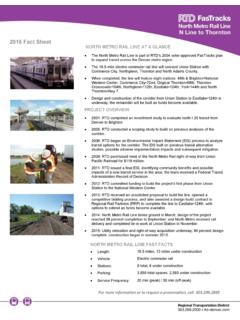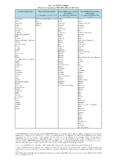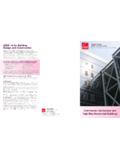Transcription of Resolution 017 -Revised Strategic Plan for Transit ...
1 Strategic plan for Transit oriented Development Revision 2, September 2010. This is a controlled document; please do not dupli- cate. If additional copies are required, please request them from the FasTracks Document Control. This will assure that all recipients of the document receive revisions and additions. Approved By: Bill Van Meter, Assistant General Manager, Planning September 2, 2010. Strategic plan for Transit oriented Development TABLE OF CONTENTS. INTRODUCTION .. 1-1. Regional Context .. 1-1. plan Organization .. 1-3. Transit oriented DEVELOPMENT POLICY .. 2-1. Policy Adoption .. 2-1. Definition of TOD .. 2-1. Basis for TOD Policy .. 2-2. RTD Power of Eminent Domain .. 2-3. TOD Vision .. 2-3. Goals and Strategies.
2 2-3. TOD PROCESS 3-1. Roles in TOD Implementation .. 3-1. RTD .. 3-2. Local Government .. 3-3. Developers .. 3-5. Regional Stakeholders and TOD Resources .. 3-5. Station Area Planning and Implementation .. 3-7. FTA Project Development Process .. 3-7. Relationship of the TOD process to FTA Project Development Process .. 3-9. RTD Internal Review and Prioritization Process for TOD .. 3-10. Staff involved and roles in process .. 3-10. Transit Access 3-11. Role of RTD 3-12. RTD Prioritization Process for TOD .. 3-12. Joint Development .. 3-13. Joint Development Guidelines and Criteria .. 3-14. Joint Development Proposal 3-15. Solicited Joint Development Proposal Process .. 3-16. Unsolicited Joint Development Proposal Process.
3 3-17. BENCHMARKING .. 4-1. APPENDIX .. 5-1. Process to Evaluate Mixed Income Housing Opportunities for Joint Development .. 5-1. FTA Proposed Joint Development Checklist .. 5-3. List of Abbreviations .. 5-4. Rev. 2 i September 2, 2010. Strategic plan for Transit oriented Development INTRODUCTION. Regional Context The Denver metropolitan area is home to more than million people. This represents more than half the population of Colorado, which was the third-fastest growing state in the na- tion during the 1990s and is the eighth-fastest growing since 2000. Metro Vision 2035, the Denver Regional Council of Governments (DRCOG) 25-year plan for growth and develop- ment, projects the region to grow by more than 50 percent to a total of million residents along with 950,000 new jobs by 2035.
4 This growth will place a tremendous strain on the region's already congested transportation system. In 2006, DRCOG identified 1,460 lane miles of congested freeways and arterials. This figure is forecast to double by 2035. FasTracks, the Regional Transportation District's (RTD's) multi-billion dollar comprehensive Transit plan , responds to the growing transportation needs of the Denver region by imple- menting new rapid Transit and expanding and improving bus service throughout its service district (see Exhibit 1-1). Passed by a 58-percent majority in 2004, FasTracks plans for 122. miles of new light-rail and commuter rail service, along with 18 miles of bus rapid Transit (BRT), and 57 proposed new stations. FasTracks has the following three core goals: Provide improved transportation choices and options to the citizens of the District, Increase Transit mode share during peak travel times, and Establish a proactive plan that balances Transit needs with future regional growth.
5 FasTracks offers an unparalleled opportunity no other region today is making this scale of commitment to invest in Transit . The dividends of this investment will come in the form of an enhanced quality of life, which for decades to come will provide metropolitan Denver with a competitive advantage for economic development opportunities compared to other regions. One key to realizing these benefits lies with the region's ability to implement Transit - oriented development (TOD). TOD is a specific approach to developing the built environment not a style of urban design or a description of physical location. At its essence, TOD means devel- opment with a functional relationship to Transit , allowing it to achieve synergies that enhance the value of both.
6 For example, TOD can make Transit systems more efficient and cost effec- tive by increasing off-peak ridership. In addition, studies have shown that proximity to Transit can yield a premium for property values. In most cases TOD requires collaboration among the parties whose interests converge at Transit facilities: the Transit agency, local government, private developers/property owners, and community stakeholders to be successful. As the regional Transit agency, RTD's primary role is to develop and operate this public infrastructure system. RTD's expansion of the regional Transit system will provide more transportation choices and make public Transit a more attractive travel option the first two goals of FasTracks.
7 But local government jurisdictions will play a key role in determining the success of the third goal, as well as a supportive role for the first two, by using their power Rev. 2 1-1 September 2, 2010. Strategic plan for Transit oriented Development to regulate land use and development. Private developers will play a critical role by proposing new projects and providing their financing knowledge and construction muscle to develop real estate at and around Transit facilities. Community stakeholders will prepare the canvas for this development by articulating a vision for their neighborhoods for which Transit can act as a catalyst to achieve. As FasTracks moves from planning to implementation, RTD will need to play an expanded role in helping deliver livable communities as a partner with local governments, developers and community stakeholders.
8 Exhibit 1-1: FasTracks System Map Rev. 2 1-2 September 2, 2010. Strategic plan for Transit oriented Development plan Organization Implementing TOD requires regional collaboration across political boundaries, institutional sectors, and professional disciplines. This document provides a Strategic plan for RTD to per- form its role in implementing TOD in the Denver region. It establishes RTD's TOD policy, of- fering the agency's vision for TOD, articulating its goals related to TOD, and recommending strategies for how to achieve each. The plan also describes the process for how RTD plans to implement TOD, defining its role in relationship to those of other major stakeholders, as well as the timeline and milestones for TOD in relationship to the Transit project development process.
9 It describes the process and evaluation criteria for joint development proposals . those both requested by RTD and unsolicited, as well as RTD's internal review protocols for such proposals. Finally, the plan explains how RTD and its partner institutions will measure and benchmark the implementation of TOD through mechanisms such as RTD's annual TOD. Status Report and the Quality of Life (QoL) study. Rev. 2 1-3 September 2, 2010. Strategic plan for Transit oriented Development Transit oriented DEVELOPMENT POLICY. Policy Adoption The RTD Board of Directors passed and adopted the following Transit oriented Development Policy on the 18th day of April 2006 (amended September 16, 2008 and September 21, 2010) as the framework to support TOD planning and development at existing and future stations throughout the district.
10 Definition of TOD. While TOD can have many physical forms, it generally includes the following design prin- ciples: More compact and dense development within a 10-minute walk or mile distance around Transit facilities compared to existing development patterns in the same area;. A mix of uses either horizontal or vertical usually including residential, retail, and office employment;. High-quality, pedestrian- oriented urban design and streetscapes. By focusing compact development around Transit stations, TOD capitalizes on the value of public infrastructure investments and promotes sustainability. These development synergies promote increased Transit ridership and an integrated station environment with more passen- ger amenities.






